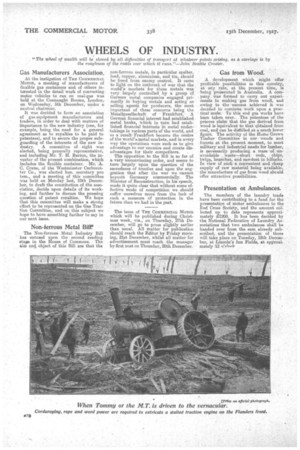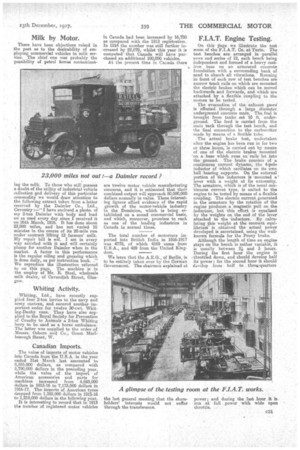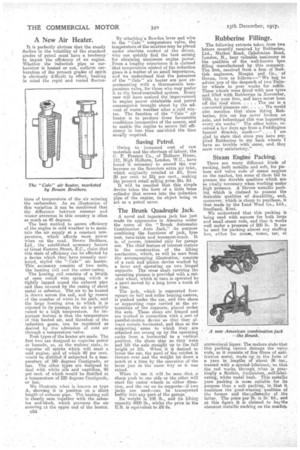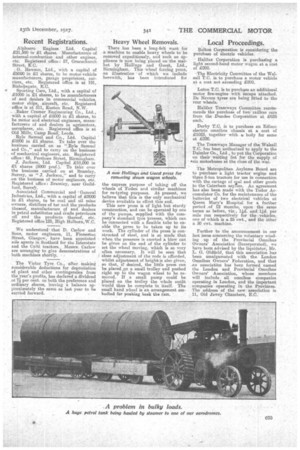WHEELS OF INDUSTRY.
Page 6

Page 7

Page 10

Page 11

If you've noticed an error in this article please click here to report it so we can fix it.
"The wheel of wealth will be slowed by all difficulties of transport at whatever points a2-ising, as a carriage is by the roughness of the roads over which it runs."--4ohn Beattie Crozier.
Gas Manufacturers Association.
At the instigation of THE CosrmErtersi Mo-roP, a meeting of manufacturers of flexible gas containers and of others in. tested in the detail-work of converting motor vehicles to run on coal-gas was held at the Connaught Rooms, London,on Wednesday, 5th December, under a neutral chairman.
It was decided to form an association of gas-equipment manufacturers and traders, in order to deal with matters of importance to the new industry (one, for example, being the need for a general agreement as to royalties to be paid to patentees), and to secure the proper safeguarding of the interests of the new in"dustry. A committee of eight was elected, being generally representative, and including Mr. T. H. Barton, the inventor of the present combination, which includes the flexible container. Mr. A. C. Crane, of the Westminster Carburetter Co., was elected hon. secretary pro tern., and a meeting of this committee was held on Monday last, 10th December, to draft the constitution of the association, decide upon details of its working, and further to discuss the pressing question of patent royalties. We hope that this committee will make a strong effort to be represented an the Gas Traction Committee, and on this subject we hope to have something further to say in our next issue.
Non-ferrous Metal Bill"
The Non-ferrous Metal Industry Bill has entesed upon the second reading stage in the House of Commons, The aim and object of this Bill are that the
non-ferrous metals, in particular spelter, lead, copper, aluminium, and tin, should befreed from enemy control. It came to light on the outbreak of war that the world's markets for these metals was very largely controlled by a group of German metal companies engaged primarily in buying metals and acting as selling agents for producers, the most important of these concerns being the MetallgeselLsehaft of Frankfurt. A German financial interest-had established metal banks, which in turn had established finanmai interests in metal under-takings in various parts of the world, and asa'resalt.Frankfurt became the centre of the world's:metal-markets, and in every way the operations were such as to give advantage to our -enemies and create dis
advantages for their competitors. .
The opposition to the Bill is so far of a very unconvincing order, and seems to turn largely upon the question of the sacredness of treaties and upon the suggestion that after the war we icannot boycott Germany. commercially. The Minister of Reconstruction, in his speech, made it quite clear that without some effective mode of competition we should suffer ourselves more from the lack of such a measure of protection in the future than we had in the past.
The issue of THE COMVIEROIAL MOTOR which will be published during Christmas week, viz., on Thursday, 27th December, will go to press slightly earlier than usual. All matter for publication should reach the Editor by Friday morning, 21st December, whilst all matter for advertisement must reach the manager by first post an Thursday, 20th December.
Gas from WoOd.
A development which might offer profitable poSsibilities in this country, at any rate; at 'the present time, is -being prosecuted in Australia. A company Was formedto carry out .experiments in making gas from wood, and owing to the ,success achieved it was decided to continue work upon a practical scale. To this end gas works have been taken aver.. The patentees of the process claimthat the gas derived from wood is equivalent to that obtained from coal, and can be distilled at a_much lower figure. The activity of the Horne Grown Timber • Committee in our; woodsand forests at the present. moment, to theet military and industrial needs for lumber, is necessarily producing n mass of up
avoidable waste short ends, chips, twigs, branches, and sawdust in hillocks. In view of rsii_ch.' a convenient and cheap supply of raw 'Materialbeing aVailable, the manufacture of gas from wood sheuld offer attractive' possibilities.
Presentation ot Ambulances.
The members of the laundry trade have been Contributing to a fund for the presentation of motor ambulanceS to the Red Cross Society, and the amount cols lected up to date represents approximately £1200. It has been decided by the National Federation of Laundry Associations that two ambulances shall be handed over from the sum already subscribed, and the presentation of these will take place on Tuesday, 18th December, at Lincoln'S Inn Fields, at approximately 12 o'c/ock
Milk by Motor.
There have been objections raised in the past as to the desirability of employing commercial vehicles in milk service. The chief one was probably the possibility of petrol tomes contatninat
ing the milk. To those who still possess a doubt of the utility of industrial vehicle collection and delivery of this particular commodity we would draw attention to the following extract taken from a•letter received by the Daimler Co., Ltd., Coventry:—, have enclosed a photo. of my 2-ton Daimler with body and load on as used every day since I received it on 26th March, 1916. It has done about 23,000 'miles, and has not varied 10 minutes in the course of its 20-mile run under contract lifting 12 farmers' milk. My repair bill is nil. I am in every way satisfied with it and will certainly plump for another Daimler when in the market. A factor in this performance is the regular oiling and greasing which is done daily, as per instruction book. ." We reproduce the illustration referred to on this page. The machine is in the employ of Mr. R. Steel, wholesale milk dealer, of Cavendish Street, Glasgow.
Whiting Activity.
Whiting, Ltd., have recently supplied four 2401 lorries to the navy and army canteen, and secured another important order for twelve 30-cwt. Whiting-Denby vans. They have also supplied to the Royal Society for Prevention of Cruelty to °Animals a 2-ton Whiting lorry to be used as a horse' ambulance. The latter was supplied to the order.of , Messrs. Osborn and Co., Great Marlborough Street, W.
Canadian Imports.
The value of imports of motor vehicles into Canada from the U.S.A. in the year ended 31st March last amounted to 8,555,000 dollars, as compared with 5,790,000 dollars in the preceding year, while the value of the import of American accessories and parts for machines increased from 4,693,000 dollars in 1915-16 to 7,173,000 dollars in 1916-17. The imports of American tyres dropped from 1,389,000 dollars in 1915-16 to 1,218,000 dollars in the following year. It is interesting to record that in 1913 the number of registered motor vehicles
in Canada had been increased by 16,780 as compared with the 1912 registration. In 1914 the number was still further in...creased by 22,070, whilst this year it is computed' that Canada will have purchased an additional 100,000 vehicles.
At the present time in Canada there are twelve motor vehicle manufacturing concerns, and it is estimated that their combined output will approach 50,000,000 dollars annually in value. These interesting figures afford evidence of the rapid growth of the motor-vehicle industry in the Dominion., which is being established on a sound commercial basis, and which, moreover, promises to rank as one of the leading industries in Canada in normal times.
The total number of motorcars imported into British India in 1916-1917 was 4778, of which 4169 came from U.S.A., and 489 from the United Kingdom.
We learn that the A.E.G., of Berlin, is to be entirely taken over by the German Government. The chairman explained at the last general meeting that the shareholders' interests would not suffer through the transference,
F.I.A.T. Engine Testing.
On this page we illustrate the test room of the FIAT. Co. at Turin. The test benches are arranged in parallel rows and series of 12, each bench being independent and formed of a heavy cast , iron base on an armoured concrete foundation with a surrounding bank of sand to absorb all vibrations. Running in front of each row of test benches are narrow track rails on which are mounted the electric brakes which can be moved backwards and forwards, and which are attached by a flexible coupling to the motors to be tested.
The evacuation of the exhaust gases' is effected through a large diameter underground concrete main. The, fuel is brought from tanks set 10 ft. underground. The feed is carried from the main tank through the test bench, and the final connection to the carburetter made by means of a flexible tube.
• The actual brake test, undertaken. after the engine has been run in for two or three hours, 'is carried out by means of one of the electric brakes mounted on a base which runs on rails let into the ground. The brake consists of a continuous current dynamo, the 4-pole inductor of which oscillates on its own ball bearing supports. On the external portion of the inductors is mounted a lever with a weight at its extremity. The armature, which is of the usual continuous current type, is united to the engine to be tested by means of a flexible coupling. The electric current generated in the armature by the rotation of the engine produces a magnetic pull on the inductors, but this effort is equalized by the weights on the end of the lever attached to the 'inductors. By calculating this weight at the moment equilibriuni is obtained the actual power developed is ascertained, using the wellknown formula for the Prony brake.
Although the length of time an engine stays on the bench is rather variable, it is usually between 2L and 3 hours. During the first hour the engine is throttled down, and should develop half its power ; for the second hour it should develop from half to thret-quarters power; and during the last hour it is run at full power with wide open throttle.
A New Air Heater.
It is perfectly obvious that the steady decline m the volatility of the standard grades of petrol meet have a tendency' to impair the efficiency of an engine. Whether the induction pipe or carburetter is heated or not, uniform carburation of the present grades of spirit is obviously difficult to effect, bearing in mind the rapid 'and varied fluctua tions of temperature of the air entering the carburetter. As an illustration of this variation it can be mentioned that the difference between summer and winter extremes in this country is often as much as 40 degrees.
The best method to assure efficiency of the engine in cold weather is to maintain the air eupply at a constant temperature, which affords most power when on the road. Brown Brothers, Ltd., the established accessory factors of Great Eastern Street, E.G., claim that this state of efficiency can be effected by a device which they 'have recently marketed, styled the " Oslo" air heater. This accessory consists of two units, the heating coil and the outer casing. The heating coil consists of a length of open coiled wire spring which is tightly lapped round the exhaust pipe and then covered by the casing of sheet metal or asbestos. The air to be heated is drawn across the coil, and by reason of the number of wires in its path,' and the large heating area to which it is exposed in its passage, the air is quickly raised to a high temperature. An important feature is that the temperature of this heated air, and therefore of the induction gases, can be regulated as desired by the admission of cold air through a temperaterre'valve.
Four types of the heater are made. The first two are designed to vaporize petrol or benzole, or, as the makers state, ,to vaporize all spirits which will start ,a cold engine, and of which 95 per cent. would he distilled if subjected to a temperature of 160 degrees Centigrade, or less. The other types are designed to deal with white oils and naphthas, 95 per cent, of which would be distilled at a temperature of 220 degrees Centigrade, or less.
We illustrate what is known as type A, showing it in position on a short length of exhaust pipe. The heating coil is clearly seen together with the asbestos end-block, which prevents the air entering et the upper end of the heater.
c34 By attaching a Bowden lever and wire to the " Cabo " temperature valve, the temperature of the mixture may be placed under absolute control of the driver, who can quickly find the best setting for obtairung maximum engine power. From a lengthy experience it is claimed that temperature control of the induction gases is a matter of no small importance, and we understand that the patentees of the " Cabo " air heater are now experimenting with a thermostatic temperature valve, for those who may prefer it to the hand-controlled system. Every user will have noticed the improvement in engine power obtainable and petrol consumption brought about by the advent of warm weather after a-cold winter. The function of the "Oslo " air heater is to produce these favourable conditions irrespective of the season, and to enable the engine to secure full efficiency in less than one-third the time usually required. .
Saving Petrol.
Owing to increased cost of raw materials and the shortage of 'labour, the C. P. Preston Co., of Holborn House, 112, High Hollidrn, London, W.C., have, found 'it necessary to amend the war increase on the Saunders extra air inlet, which originally retailed at 21, from 20 per cent. to 34 per cent., making the present retail selling price 26s. 8d,
'It will be recalled that this simple device takes the form of a little brass cylinder that screws into the :induction pipe of the engine, its object being to act as a petrol saver.
The Brunk Quadruple Jack.
A novel and ingenious jack has just made its appearance in America under the name of the ' Brunk Automatic Combination Auto Jack," its purpose combining the functions of jack tyre rest, turn-table and transport-truck. It is, of course, intended only for garage use. The chief feature of interest centres in the construction of the lifting mechanism, which, as will be seen from the accompanying illustration, consists of a rack and 'pinion device worked by a lever and operating on two hinged
supports. The cross shaft carrying the operating pinions is provided with a ratchet wheel, which in turn is operated by a pawl moved by a long lever a tooth at a time.
The jack, which is supported foursquare on ball and roller bearing castors, is pushed under the car, amid two shoes or supporting cups carried at the extremities of the supports, placed under the axle. These shoes are hinged and are worked in connection with a sort of parallel-motion device 'so that they always remain horizontal, and thus as the Supporting arms to which they, are attached are swung up by the operating racke from a horizontal to a, vertical position, the shoes stay as they were and lift the axle straight up to the full" height or lift. When it is desired to lower the car, the pawl of the ratchet is thrown over and the weight let down a notch at a time by the operation of the lever just in the same way as it was raised.
When in use it will be seen :that a sharp push to one side or the .other will start the castor wheels in either direction, and the car on its supports—if two tacks are used—can be transported ily into any part of the garage.
Its weight is 100 lb., and its lifting capacity 5000 lb., whilst the price in the U.S. is equivalent to £6 6s.
Rubberine Fillings.
The following extracts taken from two letters recently received by Bubberine, Ltd., Market Road, Caledonian Road, London, N., bear valuable testimony to the qualities of the well-known tyre filling manufactured by this company. The first, received from a firm of Scottish engineers, Morgan and Co., of Govan, runs as follows :—" We beg to advise you of the despatch of two Daimler wheels to your works for refills. These wheels were fitted 'with new tyres and filled with Rubberiyie in November, 1916, by your firm, and have never been off the road since The cos is a
converted pleasure car We would
also mention that since fitting Rubberinc, this car has never broken an axle, and beforehand this was happening every six weeks." The other letter, received a few days ago from a Paddington funeral director, reads :—" . . I am glad to state that since you have supplied Ruleberine to my back wheels I have no trouble with same, and Ahoy seem very satisfactory."
Steam Engine Packing.
There are many different kinds of packing, both metallic and soft, for pistons and valve rods of steam engines on the market, but some of them fail to possess the durable qualities which are so vitally necessary when working under high pressure. A fibrous metallic pecking which is claimed to possess the desirable qualities ed durability, and, moreover which is cheap to purchase, is that made by the Lead Wool Co., Ltd., Snodland, Kent.
We understand that this packing is being used with success for both large and small steam rods, and that it works well under a pressure of 200 lb. It can be used for packing almost any stuffing box, either for steam, water, tar, or ammoniacal liquor. The makers state that this packing cannot damage the valve rods, as it 'consists of fine fibres of antifriction metal, made'up in the form of a yarn in lengths of about 36 ins., treated with a: speciallubricaut, 'so that the rod works through, what is Practically a flexible, frictionless, self-lubeieating, white metal bush. This metallic yarn packing is more suitable for its purpose than a soft packing, in that it combines the good-wearing qualities of the former and thetieresticity of .the latter. The price per lb. is 2s. 6d., and at this figure it as claimed to bee the cheapest metallic packing on the market.
Recent Registrations.
Alphaero Engines Ltd. Capital 221,500 in 21 shires. Manufacturers of internal-combustion and other engines, etc: Registered office: 57, Gracechurch Street, E.C.
, G. Hewson, Ltd., with a capital of £5000 in 21 shares, to be motor-vehicle manufacturers garage proprietors, carriers, etc. Registered office is at 191, Bishepsgate, E.C.
Sporting Cars, Ltd., with a capital of £1000 in 21 shares, to be manufacturers of and dealers in commercial vehicles, motor ships, aircraft, etc. Registered office is at 311, Euston Road, N.W. . Baker Cramer Engineering Co., Ltd., with a capital of £5000 in 21. shares, to be motor and electrical engineers, manufacturers of and dealers in agrimotors, aeroplanes, etc. Registered office is at Old Mills, Camp Road, Leeds. Ryle Samuel and Co., Ltd. Capital 21000 in 21 shares. To take over the business carried' on as " Ryle Samuel and Co.," and to carry on the businessof mechanical engineers, etc. Registered office : 66, Pershore Street, Birmingham. J. Jackson, Ltd. Capital £10,000 in £1 shares (5000 pref.). To take over the business carried on at 13ramley, Surrey, as "J. Jackson," and to carry on the business of motor engineers, etc. Registered office .Bramley, near Guildford, Surrels
Associated Commercial and General Industries, Ltd., with a capital of 22000 in 21 shares, to be coal and oil mine owners, distillers of tar and the products theseof, manufacturers osf and dealers in petrol substitutes and Crude petroleum oil and the products thereof, etc. Registered office 125, High Tiolborn,I/V.C.
We understand. that D. Carlow and Sons, motor engineers, 11, Finneston Street, Glasgow, have been appointed sole agents in Scotland for the Interstate and the Culti tractors. Messrs. Carlow are arranging to give demonstrations of both machines shortly.
The Victor TyreCo., after making eonsiderable deductions for depreciation of plant and other contingencies from the year's profits, has declared a dividend oi 74 per cent. on both the preference and ordinary shares, leaving a balance approximately the same as last year to be carried forward.
Heavy Wheel Removals.
• There has been a long-felt want for a machine to enable heavy wheels to be removed expeditiously, arid such an appliance is now being placed on the market by Hollings and Guest, Ltd., Birmingham. This wheel forcing press, an illustration ' of which we include herewith, has been introduced for the express purpose of taking off the wheels of Foden and similar machines for re-tyring purposes. At present, we believe that this is the only mechanical device available to effect this en& This new press is of• light but sturdy construction, and can be operated by one of the pumps, supplied with the company's standard tyre presses, which can be connected with a flexible tube to enable the pines to be •taken up to its work. The cylinder of the press is constructed of steel, and is so made that when the pressure is exerted a blow can be given on the end of the cylinder to set the wheel moving, which Is so very often necessary. It will be seen that / close adjustment of the rods is afforded, whilst adjustment of height is also given, so that, if desired, the little press can be placed san a small trolley and pushed right up to the wagon wheel to be removed. If a small pump could be placed on the trolley the whole outfit would thus be complete in itself. The small hand wheel is an arrangement embodied for pushing bask the ram.
Local Proceedings.
Bolton Corporation is considering the purchase of electric vehicles.
Halifax Corporation is purchasing a light second-hand motor wagon at a cost of 2200.
-The Electricity Committee of the Walsall T.C. is to purchase a motor vehicle at a cost not exceeding £200.
Luton T.C. is to purchase an additional motor fire-engine with escape attached. De Nevers tyres are being fitted to the rear wheels.
Halifax Tramways Committee recommends the purchase of two railless cars from the _Du.ndee Corporation at £625 each Derby T.C. is to purchase an Edison electric omnibus chassis at a cost of 21023, together with a body for same at £320.
The Tramways Manager of the Walsall T.C. has been authorized to apply to the Daimler Co., Ltd., to put the Corporation on their waiting list for the supply of ssix motorbuses at the close of the war.
The Metropolitan Asylums Board are to purchase a light tractor engine and three 6-ton tractors for use in connection with the cartage of evil and other goods to the Caterharn asyrum. An agreement has also been made with the Tudor Accumulator Co. for the maintenance of the batteries of two electrical vehicles at Queen Mary's Hospital for a further period ,of 12 months, upon the same terms as before, Viz., lid. and' lid. per mile run respectively for the-' vehicles, one of which is a 25 cwt., and he ether a 30 cwt. machine.
Further to the announcement in our last issue concerning the voluntary winding up of the Provincial Omnibus Owners' Association (Incorporated), we have been advised by the liquidator, Mr. L. G. Oldfield, that this association has been amalgamated with the London Omnibus Owners' Federation, and that an associatilm has been formed named the London and Provincial Omnibus Owners' Association, whose members will include all omnibus companies operating in London, and the important companies operating in the Provinces. The address of the new association is 11, Old Jewry 'Chambers, E.C.


























